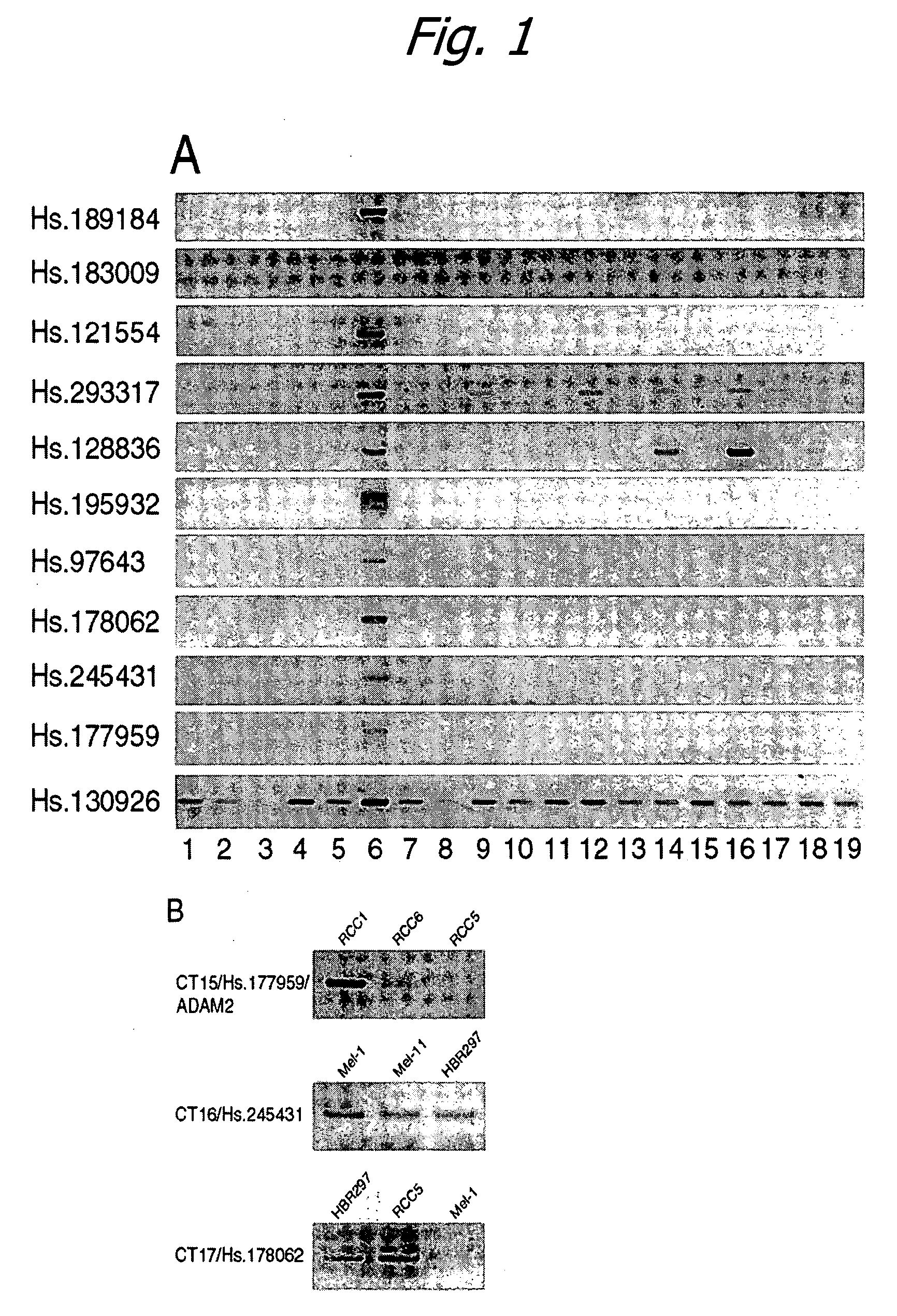Cancer-testis antigens
a technology of tumors and antigens, applied in the field of nucleic acids and encoded polypeptides, can solve the problems that the expression of these antigens in tumors of various types and sources is not universal, and achieve the effect of effective treatment, diagnosis or monitoring
- Summary
- Abstract
- Description
- Claims
- Application Information
AI Technical Summary
Benefits of technology
Problems solved by technology
Method used
Image
Examples
example 1
Identification of CT Antigens
[0190] Much attention has been given to the potential of CT antigens as targets for cancer vaccine development, and, other than mutational antigens and virus encoded antigens, they clearly represent the most specific tumor antigens discovered to date. However, the CT antigens also provide a new way to think about cancer and its evolution during the course of the disease.
[0191] The starting point for this view is the fact that CT antigen expression is restricted to early germ cell development and cancer. Germ cells give rise to gametes (oocytes and spermatocytes) and trophoblastic cells that contribute to the formation of the chorion and the placenta. Primitive germ cells arise in the wall of the yolk sack and during embryogenesis migrate to the future site of the gonads. In oogenesis, the process begins before birth, with oogonia differentiating into primary oocytes. The primary oocytes, which reach their maximal numbers during fetal development, are a...
example 2
Identification of CT Gene Products
[0209] In order to identify new CT gene products, the Unigene database, a compilation of both EST and Genbank databases, was mined for transcripts expressed exclusively in cancer and normal testis. Subsequent RT-PCR analysis of candidate transcripts identified several gene products with highly restricted mRNA expression patterns, including three newly defined CT genes.
Methods and Materials
Bioinformatic Identification of Cancer / Testis-Associated Unigene Clusters
[0210] The cDNA X profiler tool of the Cancer Genome Anatomy Project (http: / / cgap.nci.nih.gov / Tissues / xProfiler) was used to search the Unigene database in the following manner. First, 2 pools of expressed sequence tags (ESTs) were established. Pool A consisted of ESTs derived from 6 normal testis cDNA libraries, and Pool B consisted of ESTs derived from 188 tumor-derived cDNA libraries (all histological types). The X profiler search engine was directed to identify those Unigene clusters...
example 3
Confirming the Identity of the CT Antigens
[0243] The length of the sequences identified above can be extended, providing additional sequence regions with which to search for related sequences in the gene databases. Elongation of the sequences described above is done using standard methods, (e.g. PCR) to extend the DNA sequences beyond the regions currently known, particularly for those sequences that encode an apparently incomplete protein. PCR-based amplification methods include 5′RACE, which allows the isolation of the missing 5′ ends of the known, partial cDNAs. In addition, 3′ RACE is also used to extend the missing 3′ ends of the cDNAs. These additional end regions are sequenced, and the information used to screen the databases for matches and homologies.
[0244] Another method for lengthening the known sequences is through traditional library screening procedures, which allow isolation of longer sequences from libraries. Once extended sequences are identified, they are used to...
PUM
| Property | Measurement | Unit |
|---|---|---|
| Immunostimulation | aaaaa | aaaaa |
Abstract
Description
Claims
Application Information
 Login to View More
Login to View More - R&D
- Intellectual Property
- Life Sciences
- Materials
- Tech Scout
- Unparalleled Data Quality
- Higher Quality Content
- 60% Fewer Hallucinations
Browse by: Latest US Patents, China's latest patents, Technical Efficacy Thesaurus, Application Domain, Technology Topic, Popular Technical Reports.
© 2025 PatSnap. All rights reserved.Legal|Privacy policy|Modern Slavery Act Transparency Statement|Sitemap|About US| Contact US: help@patsnap.com

